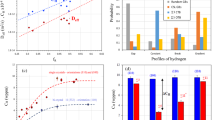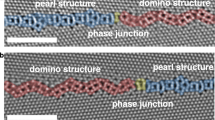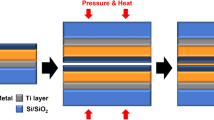Abstract
NUMEROUS workers have observed that polished surfaces of metal specimens frequently develop an etched appearance when the specimens are heated in atmospheres with which chemical reactions would not be expected. Two types of etching effect have been recorded : (a) the formation of grooves at the grain boundaries, and (b) the development, on the surfaces of crystal grains, of striations which change their direction at grain and twin boundaries. In some cases the boundary grooves form when there are no striations, but when striations appear the boundaries invariably develop grooves. Rosenhain and Ewen1, heating silver, copper and zinc in vacuo, observed boundary grooves, and on heating silver in air both grooves and striations. Together with Day and Austin2, who observed grain boundary grooves in many different types of steel heated in hydrogen, they explained the development of grooves as being due to the preferential evaporation of metal from the grain boundaries. Carpenter and Elam3 observed the development of lines at the grain boundaries of an antimonytin alloy (1½ per cent antimony), and said that the lines were really differences of level and were only produced on cooling. Rawdon and Berglund4 observed striations on iron heated in hydrogen and attributed them to slight volatilization of the polished surface. Johnson5, heating tungsten in nitrogen and argon, observed striations in wires carrying direct current, which he ascribed to the migration of positive tungsten atom-cores over the surface under the action of the electric field. Elam6 found that when copper was heated in vacuo, striations only appeared when cuprous oxide was present, and explained their appearance as being due to the differential oxidation of the copper along certain crystallographic planes followed by the evaporation of the oxide. Gwathmey and Benton7, heating a spherical single crystal of copper in air at 0.3 mm. pressure, found that fine striations appeared which seemed to be due to the development of specific crystallographic planes in the surface. These striations were diminished when the specimen was heated in hydrogen at atmospheric pressure. Boas and Honeycombe8 reported the occurrence of striations and boundary lines in specimens of tin, zinc and cadmium, heated and cooled through a number of cycles. They suggested that the anisotropic expansion of the grains of these non-cubic metals caused plastic deformation in a randomly orientated aggregate and that the striations were slip lines.
This is a preview of subscription content, access via your institution
Access options
Subscribe to this journal
Receive 51 print issues and online access
$199.00 per year
only $3.90 per issue
Buy this article
- Purchase on SpringerLink
- Instant access to full article PDF
Prices may be subject to local taxes which are calculated during checkout
Similar content being viewed by others
References
Rosenhain and Ewen, J. Inst. Metals, 8, 149 (1912). Veldkamp and Knol, Physica, 4, 166 (1937).
Day and Austin, Trans. Amer. Soc. Metals, 28, 354 (1940).
Carpenter and Elam, J. Inst. Metals, 24, 83 (1920).
Rawdon and Berglund, Sci. Papers Bur. Stand., No. 571, 649 (1928).
Johnson, Phys. Rev., 54, 459 (1938).
Elam, Trans. Faraday Soc., 32, 1604 (1936).
Gwathmey and Benton, J. Chem. Phys., 8, 431 (1940).
Boas and Honeycombe, Proc. Roy. Soc., A, 186, 57 (1946).
Benton and Drake, J. Amer. Chem. Soc., 54, 2186 (1932).
Frenkel, J. Physics (U.S.S.R.), 9, 392 (1945).
Author information
Authors and Affiliations
Rights and permissions
About this article
Cite this article
SHUTTLEWORTH, R., KING, R. & CHALMERS, B. Thermal Etching of Silver. Nature 158, 482–483 (1946). https://doi.org/10.1038/158482b0
Issue date:
DOI: https://doi.org/10.1038/158482b0
This article is cited by
-
Grain boundary grooving in a bicrystal with passivation coating
Continuum Mechanics and Thermodynamics (2021)
-
Grain Boundaries in Metals
Nature (1946)



